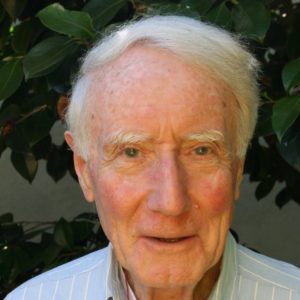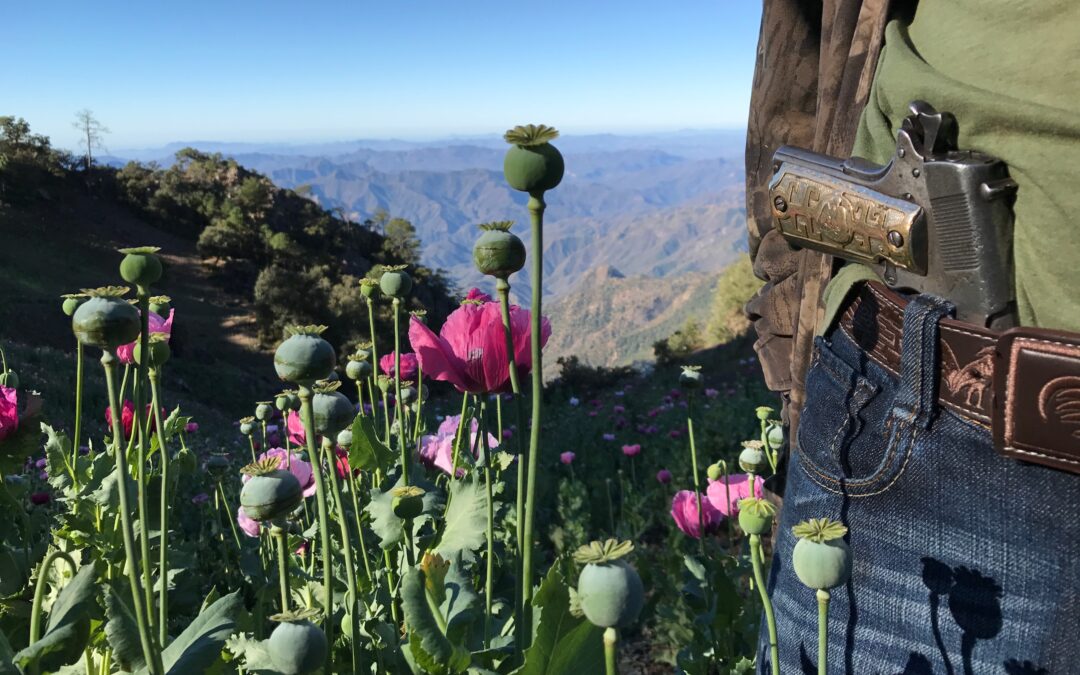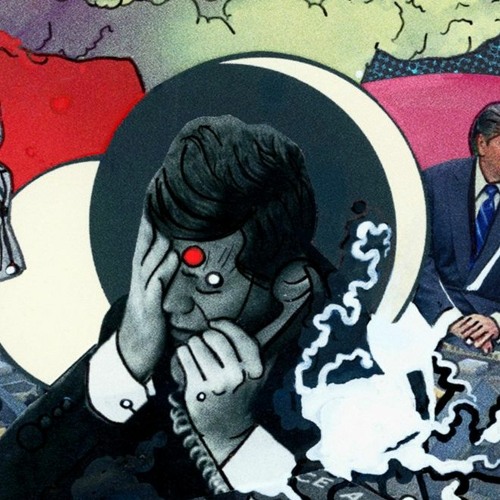Author’s Note
Updated with a new epilogue: In December of 2020, Peter Dale Scott and Aaron Good broke new ground with this investigation into the September 9, 2001 assassination of Ahmed Shah Massoud. Subsequent history suggests that Massoud’s murder served as a green light for the long-planned Global War on Terror—a campaign that sought to secure US hegemony over the Central Asian and Middle Eastern hydrocarbon heartlands.
The following complex argument is organized around five salient historical developments preceding September 11, 2001: (1) the incremental penetration of American military, political, and economic power into Central Asia following the dissolution of the Soviet Union, (2) the drafting in New York and London of the letter of introduction used by assassins to kill anti-Taliban leader Ahmed Shah Massoud, on September 9, 2001, (3) US Government knowledge of the letter, (4) Massoud’s opposition to a US invasion of Afghanistan, and (5) White House planning for military involvement in Afghanistan on September 10, the day after Massoud’s murder and one day before 9/11.
Prequel to Terror:
The 9/9 Massoud Assassination
The Long Shadow of 9/11: Part 1
Underlying the complex US covert intrigues in Asia, in the decade before 9/11, are two major uncontested facts. The first is that Central Asia was then of great interest to America because of suspected massive but unproven oil reserves in the region. The second fact is that US approaches to the region were “stove-piped”—an assessment of Defense Secretary Donald Rumsfeld, later endorsed by the 9/11 Commission.1 The 9/11 Report: The National Commission on Terrorist Attacks Upon the United States (New York: St. Martin’s, 2004), 403. This is to say that different agencies of the government had different policies, based on compartmentalized intelligence which they refused to share.
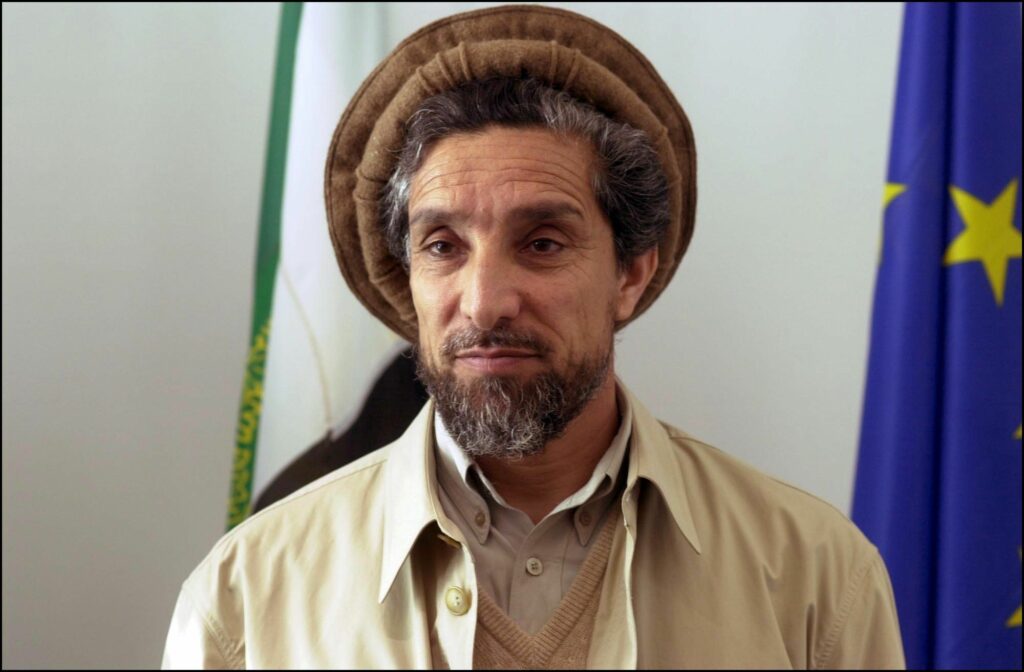
Ahmed Shah Massoud. Source: Francis Demange, Gamma-Rapho/Getty Images
This stove-piping led to conflicting US attitudes toward Ahmed Shah Massoud, the leading anti-Taliban resistance leader. Massoud was the chief of the Northern Alliance in the part of Afghanistan north of the Hindu Kush. A Tajik known as “the lion of Panjshir” for his skill as a guerrilla fighter, he received support from the CIA beginning in the 1980s when he fought against the Soviet occupation.2See Steve Coll, Ghost Wars: The Secret History of the CIA, Afghanistan, and Bin Laden, from the Soviet Invasion to September 10, 2001 (New York: Penguin Books, 2004). His assassination by Arab terrorists on September 9, 2001 was a key event preceding the 9/11 attacks and an important precondition for the US-NATO invasion of Afghanistan in October 2001.
Much of what we will have to conjecture about that scenario will remain unproven, unless and until key pieces of evidence are declassified. First among these would be the documentary history of National Security Presidential Directive (NSPD) 9, the record of Clinton and Bush planning for operations in Afghanistan.
These were originally plans—including a “Pol[itical]-Mil[itary] Plan”—against bin Laden and al-Qaeda in Afghanistan. But when finally released to the American public on October 25, 2001, NSPD-9 bore the global title “Defeating the Terrorist Threat to the United States.”
In light of Massoud’s opposition to the deployment of US soldiers to the country, we need to know: Was a US military campaign in Afghanistan already approved by the NSPD-9 planning meetings on September 4 and September 10?
In January 2001, the holdover Clinton counterterrorism czar, Richard Clarke, discussed these plans with the new National Security Adviser, Condoleezza Rice, and her Deputy, Stephen Hadley. Yet despite Clarke’s pleas for urgency, nothing was approved until September 4, 2001, when a White House meeting approved an NSPD-9 plan in principle.
A second meeting was held on September 10, which focused on the details of political and military plans in Afghanistan. This latter meeting, of course, occurred one day before 9/11. More importantly, it occurred one day after Massoud’s murder, an essential prerequisite to the military actions which the George W. Bush administration subsequently adopted.
The US Invasion Depended on Massoud’s Murder
US plans to invade landlocked Afghanistan, dating from as early as July, depended on using as their base Massoud’s territory in the impenetrable Panjshir Valley, the only Afghan region never overrun by the Taliban. They also depended on using the territory of America’s regional ally, Pakistan. Massoud and Pakistan, however, were implacable enemies. More importantly, though Massoud welcomed US military support, he was bitterly opposed to the idea of a US invasion.

The long-sought after TAPI pipeline. Source: Silk Road Briefing
In addition, Massoud had opposed a pipeline project promoted by the Union Oil Company of California (Unocal) that would have bypassed US adversaries, Russia and Iran. Rebuffing the US, Massoud had signed an agreement with Unocal’s Argentine rival for $1 million.3Coll, Ghost Wars, 329, 377.
According to journalist Steve Coll, CIA officials sought to expand covert support for Massoud, who had been receiving as much as $200,000 from the agency per month. Instead, the CIA was steamrolled by the State Department and executive branch officials who felt they could forge normal diplomatic relations with the Taliban and did not want to alienate the Pakistani government.4Coll, Ghost Wars; Steve Coll, “Ahmad Shah Massoud links with CIA: ‘The CIA had pumped cash stipends as high as $200,000 a month to Massoud and his Islamic guerrilla organization,’” Washington Post, February 23, 2004.
Within the bureaucratic turf battles, Richard Clarke was one who wanted the US to ally with Massoud.5Coll, Ghost Wars, 360. Even after 9/11, the CIA delivered a suitcase with $5 million on September 26 to the Northern Alliance headquarters of Massoud’s successor Mohammed Fahim. Located in the remote Panjshir valley of Northeast Afghanistan amidst steep mountain terrain which made it almost invulnerable to attack, this base became the initial point of entry for American troops when they first invaded Afghanistan in October 2001.
But only $1.7 million of the $5 million delivered to the late Massoud’s HQ were to support Massoud’s successor Fahim, as Clarke had originally intended. The rest was then used, not to strengthen the Alliance, but rather to break it up. The US intention was no longer to support a coalition, but to take command of operations.
With Massoud gone, the funds were parceled out by separate CIA teams to the separate warlords in the alliance. These included the CIA’s preferred allies, such as the Uzbek warlord Abdul Rashid Dostum, a client of Uzbekistan who became notorious for suffocating Taliban prisoners in a container, and the Saudi’s favorite Abdul Rasul Sayyaf, a radical Islamist who, ironically, had first invited to take refuge in Afghanistan.6Peter Tomsen, The Wars of Afghanistan: Messianic Terrorism, Tribal Conflicts, and the Failure of Great Powers (New York: Public Affairs, 2013), 597-98. Gary Schroen, First In: An Insider’s Account of How the CIA Spearheaded the War in Afghanistan (San Francisco: Presidio Press, 2006), 125, 207. Later in October Tenet reported to the principals on a CIA “meeting with leaders in the north without Fahim Khan’s approval” (Bob Woodward, Bush at War. New York: Simon & Schuster, 2003, 260).
The break-up ensured that, instead of Americans supporting an indigenous military campaign against the Taliban, the separate warlords—each with a very checkered background—would now be assisting an American campaign.7James Mann reports that the decision to help both “the Northern Alliance and Uzbek opponents of the Taliban regime” [i.e., Dostum] had already been reached at the September 4 meeting (James Mann, Rise of the Vulcans: The History of Bush’s War Cabinet [New York: Penguin, 2004], 292-93; cf. Daniel Benjamin and Steven Simon, The Age of Sacred Terror [New York: Random House, 2002], 345-46); and CIA Chief George Tenet on September 23 indicated, at a meeting in Washington, the CIA’s disapproval of the Northern Alliance as a base for US operations in Afghanistan. According to the 9/11 Commission Report, President George W. Bush had supported the introduction of ground troops into Afghanistan from the time he first took office, telling Condoleezza Rice that he was “tired of swatting at flies” and “playing defense,” wanting instead to “play offense [and] take the fight to the terrorists.”8 The 9/11 Report, 291, 292.
This scenario could never have been implemented in Afghanistan when Massoud was alive. For while Massoud was always eager for US cash and military materiel, according to three Westerners who interviewed him, including former US Ambassador Peter Tomsen, the fierce nationalist Massoud was categorically opposed to the introduction onto Afghan soil of significant numbers of US troops.9Former US Ambassador Peter Tomsen, the American who knew Massoud best, later wrote that Massoud would“have expressed opposition to the deployment of large numbers of American troops to Afghanistan” (Tomsen, The Wars of Afghanistan, 597-98. Cf. Schroen, First In, 125, 207). Tomsen added in a footnote that “According to a Massood adviser who wished to remain anonymous, in 2000 and 2001 Massood refused requests by the American and French governments to insert foreign troops into Northern Alliance-controlled areas” (Tomsen, The Wars of Afghanistan, 796 n25).
In light of Massoud’s opposition to the deployment of US soldiers to the country, we need to know: Was a US military campaign in Afghanistan already approved by the NSPD-9 planning meetings on September 4 and September 10? The records of these meetings are still classified, and reports about them are in conflict.
America and the Preparations to Murder Massoud
Another important question to ask is whether Massoud’s killing was in any way related to the 9/11 terrorist attacks. If the answer is in the affirmative, then a New York postal worker named Ahmed Abdel Sattar is a key figure tied to the larger conspiracy.10He is not to be confused with the Dahmane Abd al-Sattar, the Brussels-based Tunisian terrorist who was identified by Belgian police as one of Massoud’s two assassins masquerading as journalists (Dan Bilefsky, “Belgian Authorities Identify Terror Cell Responsible for Massoud’s Assassination,” Wall Street Journal, December 10, 2001, https://www.wsj.com/articles/SB1007934514705826480). Sattar has no Wikipedia entry, but deserves one. Together with Yassir al-Sirri, an Egyptian terrorist and refugee in London, he drafted by telephone the letter of introduction used by Massoud’s assassins, masquerading as journalists, to gain access to Massoud’s heavily guarded headquarters in the Panjshir.

The “blind sheikh” Omar Abdel Rahman. Source: AFP
Al-Sirri was a prominent international terrorist, already sentenced to death by Egyptian leader Hosni Mubarak for an assassination attempt back in 1994 which killed a schoolgirl. Sattar, in contrast, was a low profile US postal worker, but he functioned as the important go-between linking the global Islamic terrorist movement and a key leader of the international terror network, the Egyptian “blind sheikh” Omar Abdel-Rahman.
Beginning in 1987, Abdel-Rahman had been issued visas for the US, at least one of which was issued by an undercover CIA officer working in the US embassy in Sudan. Presumably, the CIA assisted Abdel-Rahman because of his involvement with recruiting Mujahideen—this despite his leadership of a terrorist group in Egypt.11Peter Bergen, Holy War, Inc.: Inside the Secret World of Osama bin Laden (New York: Free Press, 2001), 66-67.
Said one FBI field agent and counterterrorism expert, “It was no accident that the sheikh got a visa and that he’s still in the country. […] He’s here under the banner of national security, the State Department, the NSA, and the CIA.” The FBI agent pointed out that Abdel-Rahman had received a tourist visa, and eventually a green card, despite his being on a State Department terrorist watch-list which should have barred his entry into the US. The agent concluded that the “blind sheik” Abdel-Rahman was an untouchable. In reference to the bureau’s failure to investigate Abdel-Rahman’s involvement in the 1990 murder of the racist rabbi Meir Kahane, the agent said, “I haven’t seen the lone-gunman theory advocated [so forcefully] since John F. Kennedy.”12Robert I. Friedman, “The CIA and the Sheik,” The Village Voice, March 30, 1993, http://www.textfiles.com/conspiracy/wtcbomb1.txt.
In 1987, Abdel-Rahman, the leader of the Egyptian militant Islamist group , flew to Afghanistan and joined the Makhtab-al-Khidimat (the Office of Services), the Pakistan-based organization that Osama bin Laden helped finance and lead and that would later become al Qaeda. He came to New York City in 1990 and served as the spiritual leader of a Makhtab field office, the al-Kifah Center in Brooklyn. There, he helped oversee the recruiting, training, and assisting of jihadis for deployment to Afghanistan, where the CIA was covertly supporting the Mujahideen.13Peter Dale Scott, The Road to 9/11: Wealth, Empire, and the Future of America. (Berkeley: University of California Press, 2007), 145-146.
Soon after, Bosnia became a chief focus of the al-Kifah Center. By 1993, al-Kifah had set up a satellite office in Zagreb, Croatia, which was funded and directed from the Brooklyn office. Flyers for jihad in Bosnia were distributed in Boston by an al-Kifah branch in that city.14Scott, The Road to 9/11, 149. Court testimony from al-Kifah’s Clement Rodney Hampton-El suggested that the center’s Bosnian jihad operations were being jointly supported by Saudi Arabia and elements of the US national security state.15Scott, The Road to 9/11, 149-150. The jihadists were sent to fight on behalf of the Islamist regime of Aliza Izetbegović, whom the US supported against the Serbs led by Slobodan Milošević who wanted to keep the old socialist Yugoslav federation intact.16See John Y. Schindler, Unholy Terror: Bosnia, Al Qaida and the Rise of Global Jihad (London: Zenith Press, 2007).
In 1995, Abdel-Rahman was convicted of a slew of conspiracy charges growing out of the first World Trade Center bombing in 1993. In 2001, the blind sheikh was serving a life sentence in a US federal prison for his involvement in the New York City landmark terror plots. From this prison, via calls on Sattar’s telephone, he continued to give orders, including a fatwa (religious ruling) that it was lawful to rob banks and kill Jews. The FBI listened attentively to these calls, learning details about terrorists abroad, especially in Egypt, that it could then forward to the Egyptian and other interested governments.17The US Government had been listening to phone calls between Sattar and al-Sirri from at least April 1999 (Library Information and Research Service, “The Middle East,” 2008, 741).
Did elements in the US Government hear plans to assassinate Massoud, and do nothing about them? The answer is not clear from the public record. According to the New York Times:
In one such conversation last summer, another defendant, Yassir al-Sirri, an Egyptian based in London, was overheard [on government wiretaps] talking with Mr. Sattar about the drafting of a letter of introduction to serve as a cover story for two men, for possible use in Afghanistan, the official said. The two men were heard talking about a letter of general introduction, and not one that specified Mr. Massoud by name. It was clear from the context though, that the letter would be needed by someone for a secret mission, most likely in Afghanistan, the official added. Mr. Massoud was killed by two men posing as journalists about two months after the conversation between Mr. Sattar and Mr. Sirri.18Robert F. Worth, “New Yorker Is Suspected of Aiding Killers of Anti-Taliban Leader,” New York Times, May 14, 2002, https://www.nytimes.com/2002/05/14/world/new-yorker-is-suspected-of-aiding-killers-of-anti-taliban-leader.html.
The Times story leads the reader to believe that the US government did not know who in Afghanistan was the target of the letter. I find this unlikely. It knew that in late 2000 al-Qaeda and the Taliban–both with links to Pakistan’s intelligence agency, the ISI–had reached an agreement to eliminate Massoud, Pakistan’s chief enemy.19“Bin Laden… had decided to work with the Taliban and in doing so they placed themselves firmly against Massoud” (Hashmat Moslih, “Afghanistan in the shadow of Ahmad Shah Massoud,” Al Jazeera, September 9, 2014, https://www.aljazeera.com/opinions/2014/9/9/afghanistan-in-the-shadow-of-ahmad-shah-massoud/). By this time, Massoud—“thought to be Afghanistan’s greatest guerrilla fighter”—was the only resistance leader “left to fight on against the Taliban militia.”20Barry Bearak, “Afghan ‘Lion’ Fights Taliban With Rifle and Fax Machine,” New York Times, November 9, 1999, https://www.nytimes.com/1999/11/09/world/afghan-lion-fights-taliban-with-rifle-and-fax-machine.html. Thus there was really no other target in Afghanistan of similar importance. Note that, according to the Times, the date of the phone call producing the letter was “about two months” before 9/11–i.e., mid-July. Later, The New Republic reported for the first time that NSPD-9 “had an annex going back to July–contingency plans [to] attack the Taliban.”21“According to an accidentally discovered note by Pentagon PR aide Eric Ruff, Ruff suggested to Rumsfeld in a discussion of the controversy that he say ‘NSPD[-9] had an annex going back to July–contingency plans to attack Taliban.’ ” (Spencer Ackerman, “Why Pentagon officials should thank the aide who left notes in Starbucks,” TNR Online, April 1, 2004, http://www.tnr.com/doc.mhtml?i=express&s=ackerman040104).
If higher powers have taken steps to suppress the guilty involvement of Abdel-Rahman, Sattar, and al-Sirri in the assassination, is that not a strong indication that these same higher powers are themselves complicit in that assassination?
British and American legal responses to the letter of introduction, though different, attest to the importance they paid to it. In October 2001, the British arrested al-Sirri in connection with Massoud’s murder, but “Inexplicably, a British judge later cleared al-Sirri of all charges and released him, labeling him ‘an innocent fall guy.’”22Erick Stakelbeck, The Terrorist Next Door: How the Government Is Deceiving You about the Islamist Threat (Washington, D.C.: Regnery Publishing, 2011), 138. Cf. Alan Cowell, “British Court Frees a Muslim Arrested After 9/11.” New York Times, August 11, 2002, https://www.nytimes.com/2002/08/10/world/british-court-frees-a-muslim-arrested-after-9-11.html: “In May, however, a British judge said that Mr. Sirri was ‘an innocent fall guy’ and set him free, despite an indictment in the United States on charges of disseminating terrorist messages.” Meanwhile, on April 9, 2002, one month before the Times news story about him, the United States indicted both al-Sirri and Sattar–along with Lynne Stewart, the Brooklyn attorney who represented the blind sheikh and allegedly passed messages for him. But the US indictment said nothing about the lethal letter of introduction, which was never mentioned again in the US press. Instead, the defendants were accused, and eventually convicted, of conspiring “to knowingly provide material support and resources” to the Egyptian terrorist Islamic Group. For their crimes, Stewart was sentenced to 28 months in prison, Sattar to 28 years.23Stewart was re-sentenced and received ten years but received “compassionate release” and, therefore, did not serve the full sentence.

The Wall Street Journal reports on the improbably serendipitous al Qaeda laptop.
Bin Laden, rather than the “blind sheikh,” has sometimes been named as the instigator of the Massoud assassination. This conclusion is based on a trove of files, allegedly from an al-Qaeda computer, bought by a Wall Street Journal reporter in Kabul later in late 2001.24“What looked like proof positive [that bin Laden ordered the assassination] finally surfaced at the end of 2001, when computer files in Kabul belonging to bin Laden’s organization Al-Qaida (“The Base”) were found by Western journalists to contain the list of questions presented to Massoud” (William Maley, The Afghanistan Wars [London: Red Globe Press, 2020], 251, citing Alan Cullison and Andrew Higgins, “Forgotten Computer Reveals Thinking Behind Four Years of al Qaeda Doings,” Wall Street Journal, December 1, 2001). There are reasons to be skeptical of this rich find of supporting justification for America’s new War on Terror. It seems suspiciously reminiscent of the discovery of the World Trade Center bomber Ramzi Ahmed Yousef’s laptop computer six years earlier, containing evidence of “Operation Bojinka,” his alleged plan to blow up eleven US airliners.25Paul J. Smith, “Transnational Terrorism and the al Qaeda Model: Confronting New Realities,” Parameters, Summer 2002, 33. It also brings to mind the disputed computer which was used to convict the British extremist Omar Saeed Sheikh of the January 2002 murder of Wall Street Journal reporter Daniel Pearl—dubious evidence which a Pakistani court gave as a reason for overturning Sheikh’s murder conviction in 2020 (see: Saeed Shah, “Pakistani Court Overturns Murder Conviction in Killing of Wall Street Journal Reporter Daniel Pearl,” Wall Street Journal, April 2, 2020, https://www.wsj.com/articles/pakistani-court-overturns-murder-conviction-in-killing-ofwall-street-journal-reporter-11585805394.)
More significantly, there are notable unresolved contradictions in the al-Sirri letter saga. To wit, the December 2001 Wall Street Journal story about the computer files maintains that the letter of introduction was drafted by “Mohammed Zawahri,” but falsely credited to al-Sirri.26Cullison and Higgins, “Forgotten Computer Reveals Thinking Behind Four Years of al Qaeda Doings.” This is contradicted by the New York Times article of May 2002—the story which revealed that there were wiretapped conversations between al-Sirri and Sattar [the “blind sheik”’s go-between] discussing “the drafting of a letter of introduction to serve as a cover story for two men, for possible use in Afghanistan.”27Robert F. Worth, “New Yorker Is Suspected of Aiding Killers of Anti-Taliban Leader,” New York Times, May 14, 2002, https://www.nytimes.com/2002/05/14/world/new-yorker-is-suspected-of-aiding-killers-of-anti-taliban-leader.html.
Alternatively, a 2016 UK Independent story states flatly that bin Laden ordered Massoud’s assassination—an assertion presumably based on the files from the Kabul computer allegedly bought by the Wall Street Journal in 2001. However, the Independent article also states that al-Sirri himself admitted that he provided the Massoud assassins’ letter of introduction.28Kim Sengupta, “The British connection: Jihadi chain traces European terror back to 9/11,” April 20, 2016, The Independent, https://www.independent.co.uk/news/uk/crime/british-connection-jihadi-chain-traces-european-terror-back-9-11-a6992021.html. The 2016 Independent story makes no mention of Sattar or the “blind sheik”—actors whose roles in the introduction letter saga were reported in the 2002 New York Times story but never followed up on.
Massoud’s Wikipedia entry goes even further, omitting not only the “blind sheik,” but also failing to mention al-Sirri at all.29“Ahmad Shah Massoud,” Wikipedia, https://en.wikipedia.org/wiki/Ahmad_Shah_Massoud, accessed on November 25, 2020. (While Wikipedia is a problematic source for scholarly purposes, it is relevant here in that, on controversial matters, its anonymous editors typically present the prevailing conventional and/or official versions of actors and events.) Does the silence of the government and media regarding al-Sirri and the “blind sheik,” along with their connection or potential connection to US intelligence agencies, represent some sort of negative template that can help us understand the Massoud assassination, 9/11, and the Afghanistan War—a conflict which eventually became the longest war in US history?
To put it another way: If higher powers have taken steps to suppress the guilty involvement of Abdel-Rahman, Sattar, and al-Sirri in the assassination, is that not a strong indication that these same higher powers are themselves complicit in that assassination?
The Doubleness, and Stove-Piping, of US Policy
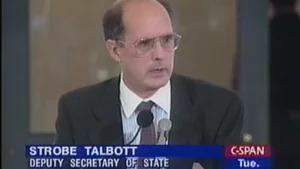
Strobe Talbott gives a speech on US Policy in Central Asia. Source: CSPAN
Massoud’s fate was at the center of important policy differences inside the US Government, going back for some years. Bill Clinton entrusted his policies for Central Asia to his Deputy Secretary of State, Strobe Talbott, a personal friend from his Oxford days. In an important speech of July 1997,
Talbott outlined four dimensions of US support to the countries of the Caucasus and Central Asia: 1) The promotion of democracy; 2) The creation of free market economies; 3) The sponsorship of peace and cooperation, within and among the countries of the region: and, 4) integration into the larger international community.… Inveighing against what he considers an outdated conception of competition in the Caucasus and Central Asia, Mr. Talbott admonished any who would consider the “Great Game” as a model on which to base current views of the region. He proposed, instead, an arrangement where everyone cooperates and everyone wins.30James MacDougall, “A New Stage in U.S.-Caspian Sea Basin Relations,” Central Asia, 5 (11), 1997; quoting from Ariel Cohen, “U.S. Policy in the Caucasus and Central Asia: Building A New ‘Silk Road’ to Economic Prosperity,” Heritage Foundation, July 24, 1997. In October 1997 Sen. Sam Brownback introduced a bill, the Silk Road Strategy Act of 1997 (S. 1344), providing incentives for the new Central Asian states to cooperate with the United States, rather than with Russia or Iran.
Meanwhile, behind this verbal debate, the CIA and Pentagon–through NATO–were developing a “forward strategy” in the area that was antithetical to Talbott’s vision. Under the umbrella of NATO’s Partnership for Peace (PFP) Program, the Pentagon in 1997 began military training exercises with Uzbekistan, Kazakhstan, and Kyrgyzstan, as “the embryo of a NATO-led military force in the region.”31Ariel Cohen, Eurasia In Balance: The US and the Regional Power Shift (UK: Ashgate Publishing, 2005), 107. These CENTRAZBAT exercises had in mind the possible future deployment of US combat forces. A deputy assistant secretary of defense, Catherine Kelleher, cited “the presence of enormous energy resources” as a justification for American military involvement.32Michael Klare, Blood and Oil (New York: Metropolitan Books/Henry Holt, 2004), 135-36; citing R. Jeffrey Smith, “U.S. Leads Peacekeeping Drill in Kazakhstan,” Washington Post, September 15, 1997. Cf. Kenley Butler, “U.S. Military Cooperation with the Central Asian States,” September 17, 2001, http://cns.miis.edu/archive/wtc01/uscamil.htm. Uzbekistan, which Brzezinski in his 1997 book The Grand Chessboard singled out for its geopolitical importance,33Zbigniew Brzezinski, The Grand Chessboard: American Primacy and Its Geostrategic Imperatives (New York: Basic Books, 1997), 121. became the linchpin of US training exercises.
The CIA had collaborated closely with the Pentagon and the Uzbek army and secret services since 1997, providing training, equipment, and mentoring in the hope of using Uzbek Special Forces to snatch Osama bin Laden from Afghanistan.34Ahmed Rashid, Descent into Chaos: The United States and the Failure of Nation Building in Pakistan, Afghanistan, and Central Asia (New York: Viking, 2008), 70, 69; citing Ahmed Rashid, “US Builds Alliances in Central Asia,” Far Eastern Economic Review, May 1, 2000. Cf. Steve Coll, Ghost Wars, 457; “A team of CIA operators from the agency’s Counterterrorist Center flew to Dushanbe, Tajikistan, in October 1999. Code-named JAWBREAKER-5, the group was led by the chief of the center’s Osama bin Laden unit, known to his colleagues as Rich [Richard Blee], a veteran of CIA postings in Algiers and elsewhere in the developing world.” [See: Steve Coll, “Flawed Ally Was Hunt’s Best Hope,” Washington Post, February 23, 2004, A01, https://www.washingtonpost.com/wp-dyn/articles/A62889-2004Feb22.html]. In 1999, Cofer Black and Richard Blee of the CIA’s Counterterrorism Center (CTC) flew together into Tashkent and negotiated a new liaison agreement with Uzbekistan. Soon thereafter, according to the Washington Post, the US and Uzbekistan “quietly conducted joint covert operations aimed at countering Afghanistan’s ruling Taliban regime and its terrorist allies.”35Thomas E. Ricks and Susan B. Glasser, “U.S., Uzbekistan confirm covert effort,” Washington Post, October 14, 2001, http://www.washingtonpost.com/ac2/wp-dyn/A55834-2001Oct13; Cf. Times of India, October 14, 2001; Vanity Fair, November 2004, http://www.vanityfair.com/politics/features/2004/11/path-to-9-11-200411: “Black and Rich’s solution to going after bin Laden was … to initiate a series of covert operations with Islam Karimov, the brutal, autocratic president of Uzbekistan, and Ahmed Shah Massoud, the leader of the Northern Alliance in Afghanistan.” Note that the CIA was no longer targeting just bin Laden, but the entire Taliban Afghan government.
Eventually, the US-Uzbek alliance expanded to include the Northern Alliance in Afghanistan. In October of 1999, Blee met with Massoud and agreed to lobby Washington for increased US support for the Northern Alliance.36Coll, Ghost Wars, 467-69. US special forces had begun working more directly with the Uzbek military by 2000.37Ricks and Glasser, “U.S., Uzbekistan confirm covert effort.” [See: https://www.chron.com/news/article/U-S-Uzbekistan-confirm-covert-effort-2021728.php]. In the wake of the bin Laden-orchestrated USS Cole bombing in October, Blee pressed to expand the Uzbek military mission into a joint attack force with the Northern Alliance, but Clinton objected.38Coll, Ghost Wars, 539-541.
Within the next administration in Washington, Bush deputies revived the plans of Blee and Black, supported by counter-terrorism director Richard Clarke.39Coll, Ghost Wars, 560-561. Meanwhile, throughout 2001, officials from the US and other countries were meeting with the Taliban. One attendee of these meetings was Niaz Naik, the former Pakistani Minister for Foreign Affairs. At a July meeting in Berlin, the talks focused on the creation of a unity government in Afghanistan. Said Naik, “If the Taliban had accepted this coalition, they would have immediately received international economic aid … And the pipelines from Kazakhstan and Uzbekistan would have come.”40Julio Godoy, “U.S. Policy towards Taliban Influenced by Oil,” Inter Press Service, November 15, 2001, In August 2009, Naik was tortured and murdered in his house in Islamabad in an unsolved case. Whether this had anything to do with his disclosure of Simon’s threats remains uncertain. https://en.wikipedia.org/wiki/Niaz_Naik
According to Naik, a US representative–former ambassador to Pakistan, Tom Simons–made open threats to the Taliban and Pakistan: “Simons said, ‘either the Taliban behave as they ought to, or Pakistan convinces them to do so, or we will use another option.’ The words Simons used were ‘a military operation.’”41Godoy, “US Policy towards Taliban Influenced by Oil;” Damien Cave, “The Conspiracy Theory That Wouldn’t Die,” Salon, August 16, 2002, https://www.salon.com/2002/08/16/forbidden_truth/. The pipelines referenced by Naik would have included, first and foremost, Unocal’s aforementioned Turkmenistan-Afghanistan-Pakistan-India (TAPI) pipeline.
Naik later provided more details about the negotiations with the Taliban, talks in which the US was represented by Tom Simons, former assistant secretary of state for South Asian affairs Karl “Rick” Inderfurth, and former State Department official in charge of Afghanistan Lee Coldren. Said Naik, “We asked them [the American delegates], when do you think you will attack Afghanistan? […] And they said, before the snow falls in Kabul. That means September, October, something like that.”42Cave, “The Conspiracy Theory that Wouldn’t Die.”
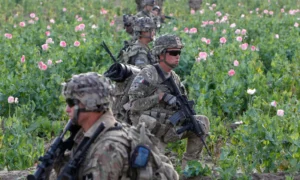
US soldiers patrolling a poppy field in Afghanistan. After the October 2001 invasion, opium exports skyrocketed. Source: Alamy
In the time preceding the 9/11 terror attacks, Uzbekistan was the key node in the CIA-Pentagon strategy for Central Asia, despite having the worst human rights record in the region. In 1999—the same year in which Black and Blee forged that new liaison agreement with Uzbekistan—President Bill Clinton, in accordance with the humane objectives expounded by Strobe Talbott, signed Executive Order 13126. This order listed commodities unacceptable for US import because they were the products of forced or indentured child labor. Among the products listed was cotton from Uzbekistan.
If human rights concerns could not prevent the CIA-Pentagon line from prevailing in Uzbekistan before 9/11, they were not going to carry the day afterward. In 2002 it was revealed that the Uzbek regime tortured political prisoners, up to and including boiling victims alive.43Farangis Najibullah, “Uzbekistan’s ‘House Of Torture,’ ” Radio Free Europe/Radio Liberty, August 5, 2012, https://www.rferl.org/a/uzbekistans-house-of-torture/24667200.html. That was a year in which the country received from the US more than $200 million in military and security aid. The US did eventually renew its human rights criticism of Uzbekistan in 2005, but only after its president expelled the Open Society Institute from the country and ordered the US to close its military base in Uzbekistan.44Craig Murray, “Why the US won’t admit it was jilted,” The Guardian, August 2, 2005, https://www.theguardian.com/politics/2005/aug/03/foreignpolicy.comment.
Deep State Pressure for a US Military Presence in Central Asia
The interest of the Pentagon and CIA in Central Asia reflected that of the US oil industry, persuaded at that time that the world’s largest unproven oil interests lay in Central Asia. Perhaps the leading spokesman of this interest was Richard Cheney, CEO of the oil field service giant Halliburton. Halliburton had been active since 1997 or earlier in developing the petroleum reserves of Central Asia, along with Chevron and Mobil. Cheney said in a speech to oil industrialists in 1998, “I cannot think of a time when we have had a region emerge as suddenly to become as strategically significant as the Caspian.”45“The Great Gas Game,” Christian Science Monitor, October 25, 2001, https://www.csmonitor.com/2001/1025/p8s1-comv.html.
At the time Cheney, along with Donald Rumsfeld, was a member of the neoconservative Project for the New American Century (PNAC), whose September 2000 report, Rebuilding America’s Defenses, had much to say about Gulf oil and the importance of retaining and strengthening “forward-based forces in the region.”46“Were 1998 Memos a Blueprint for War?” ABC News, January 6, 2006, https://abcnews.go.com/Nightline/story?id=128491&page=1. The PNAC report made little mention of Central Asia, but the region’s importance to the neoconservatives is illustrated by Cheney’s statement (above) to oil industrialists regarding the strategic significance of the Caspian basin.
Indeed, an early foothold in the region was established in Azerbaijan in the immediate aftermath of the Soviet Union’s dissolution. The country experienced a series of murky intrigues involving some combination of US intelligence operatives, oil companies, the Saudis, Pakistan’s ISI, mujahideen fighters, and heroin trafficking. It all culminated in a 1993 coup which overthrew Azerbaijan’s elected president Abulfaz Elchibey and installed a new leader, Heydar Aliyev, who shifted the country away from Russia and towards the West.47Scott, The Road to 9/11, 163-165; Alexis Rowell, “US Mercenaries Fight in Azerbaijan,” CovertAction Quarterly, Spring 1994. In 1995, the United States-Azerbaijan Chamber of Commerce was established “to facilitate business and cooperation between the United States and Azerbaijan.”48“About Us,” United States-Azerbaijan Chamber of Commerce, https://usacc.org/content.php?type=page&id=97&chi=4&par=3, September 2, 2007 webpage accessed through the Internet Archive: Wayback Machine, https://web.archive.org/web/20071009145010/https://usacc.org/content.php?type=page&id=97&chi=4&par=3.
Azerbaijan International, a print magazine founded in 1993 with offices in Baku and Los Angeles,49Azerbaijan International, https://azer.com/aiweb/categories/aboutai/aboutai.html. published an announcement from the US-Azerbaijan Chamber of Commerce stating that, “The Chamber extends deep appreciation to the following companies which have contributed to its establishment: Amoco, BP America, Chevron, Exxon, Mobil, Occidental, Panalpina, and Unocal.”50“Announcing: The US-Azerbaijan Chamber of Commerce,” Azerbaijan International, Spring 1996, 86, https://www.azer.com/aiweb/categories/magazine/41_folder/41_articles/41_chamberofcommerce.html. Serving on the council were a number of establishment “realist” and neoconservative luminaries—including James Baker III, Zbigniew Brzezinski, Henry Kissinger, Brent Scowcroft, John Sununu, Dick Cheney, and Richard Armitage.51“Profile: Officers,” United States-Azerbaijan Chamber of Commerce, http://www.usacc.org/content.php?type=page&id=2&chi=5&par=3, September 2, 2007 webpage accessed through the Internet Archive: Wayback Machine, https://web.archive.org/web/20071009145228/http://www.usacc.org/content.php?type=page&id=2&chi=5&par=3.

Brent Scowcroft, Richard Cheney, President Bush, and Colin Powell (1991). Source: Carol T. Powers
Azerbaijan in the mid-1990s served as a beachhead for US penetration into Central Asia. The US-Uzbekistan alliance, established soon after, represented a furtherance of the general thrust. By the end of 2001, in the wake of 9/11 and the launching of the Global War on Terror, the United States had also established new bases in Tajikistan and Kyrgyzstan. It was thus better positioned to influence the behavior of the newly liberated governments in the huge oil and gas region east of the Caspian, and to defend the new Chevron and ExxonMobil oil investments in Kazakhstan.
As for Afghanistan, in 1997, the UK Telegraph reported that the Taliban were “about to sign a £2 billion contract with an American oil company [California-based Unocal] to build a pipeline across the war-torn country.”52Caroline Lees, “Oil barons court Taliban in Texas,” The Telegraph, December 14, 1997, reprinted at https://mapcruzin.com/news/war111901a.htm.
Does the silence of the government and media regarding al-Sirri and the “blind sheik,” along with their connection or potential connection to US intelligence agencies, represent some sort of negative template that can help us understand the Massoud assassination, 9/11, and the Afghanistan War—a conflict which eventually became the longest war in US history?
Brzezinski even included an illustration of the proposed Unocal pipeline in his 1997 geopolitical manifesto, The Grand Chessboard.53Brzezinski, The Grand Chessboard, 146. Recall that Massoud, and thus the Northern Alliance, opposed this deal and instead signed a deal with an Argentine company. The US-Unocal TAPI pipeline deal with the Taliban never came to pass, the aforementioned negotiations coming to a close in August of 2001. In 2018, after years of war, the pipeline project was under the direction of Turkmengaz, Galkynysh – TAPI Pipeline Company, with support from the Asian Development Bank.54Turkmenistan announced in September 2020 that it intends to begin construction on a gas pipeline from the Turkmenistan-Afghanistan border to the Herat offtake point in Afghanistan, a fundamental part of the TAPI project. “Rumblings that TAPI Will Commence in 2021,” September 22, 2020, https://www.pipeline-journal.net/news/rumblings-tapi-will-commence-2021.
With talks of a unity government stalled, Bush’s cabinet on September 4, 2001, authorized the drafting of NSPD-9, a new presidential directive authorizing a large covert action program with the Northern Alliance along the lines advocated by Blee and Black. Significantly, the proposal for a joint attack force including US ground troops and Massoud’s Northern Alliance was resisted by Massoud himself.55Tomsen, The Wars of Afghanistan, 597-98, 796 n25. The problem of Massoud’s resistance to an American troop presence vanished when he was assassinated on September 9, 2001, two days before 9/11.
The Massoud Assassination and 9/11: September 2001 as Historical Black Hole
As a result of actions undertaken by powerful actors—including the CIA, the Pentagon, and US oil companies—the stage was set for the historically fateful month of September 2001. Still incompletely understood and shrouded in secrecy, key historical events of that month include official US planning on 9/4 and 9/10 for military action in Afghanistan, the 9/9 assassination of Ahmed Shah Massoud, and the terror attacks of 9/11.
In short, these events cemented an historical trajectory in which America strove to become precisely what Strobe Talbott had counseled against becoming—a dominant player in the Great Game for Central Asia. America’s military presence in greater Western/Central Asia was further consolidated by its invasion of Iraq in 2003, an option already raised before 9/11 and raised again in the hours immediately following it.
Almost two decades have passed since 9/11. The hubristic Cheney-Rumsfeld initiatives in Afghanistan and Iraq are now being wound down as failures. These failures may be a sign that decades of a so-called Pax Americana, with oil-related aggressions against states from Afghanistan to Libya, are winding down as well.
Epilogue: September 2022
By Aaron Good
When we first published this article in December of 2020, we could not have known that the longest war in US history would be over in less than a year’s time. Strangely, the timing of the US withdrawal from Afghanistan was such that on the twenty-year anniversary of 9/11, the Taliban were to hold a victory ceremony of sorts in Kabul.56Pepe Escobar, “9/9 and 9/11, 20 Years Later,” Asia Times, September 9, 2021, https://asiatimes.com/2021/09/9-9-and-9-11-20-years-later/.
In an Asia Times piece on the two-decade anniversary of the September 9, 2001 Massoud assassination and 9/11, journalist Pepe Escobar cited our article. His piece highlighted the significance of Peter Dale Scott’s discovery that the known origin point of the Massoud assassination plot was the “blind sheikh” Adbel-Rahman.57Escobar, “9/9 and 9/11, 20 Years Later.” In 2021, we recorded a discussion on this subject for the American Exception podcast featuring Peter Dale Scott, Pepe Escobar, CIA torture whistleblower John Kiriakou, and myself. During the episode (embedded above), Kiriakou confirmed and explained how the administrative measures to which Abdel-Rahman was subjected would have made it impossible for him to communicate without US security agencies being aware. This is further indication that state actors allowed Abdel-Rahman’s plot to proceed. Indeed, it begs the question as to how a blind, high-profile, imprisoned terrorist would have decided upon an action whose timing and consequences were so serendipitous for the American deep state as it was preparing to launch the Global War on Terror.
Escobar went on to reflect upon the significance of Massoud’s murder and 9/11. Summing up the world historic import, he wrote:
We may now know that the Taliban had nothing to do with 9/11. We may now know that Osama bin Laden, in an Afghan cave, may not have been the master perpetrator of 9/11. We may now know that the assassination of Massoud was a prelude to 9/11, but in a twisted way: to facilitate a pre-planned invasion of Afghanistan. And yet, like with the assassination of JFK, we may never know the full contours of the whole riddle inside an enigma. As Fitzgerald immortalized, “so we beat on, boats against the current, borne back ceaselessly into the past,” probing like mad this philosophical and existential Ground Zero, never ceasing from asking the ultimate question: Cui Bono?58Escobar, “9/9 and 9/11, 20 Years Later.”
Thusly does Escobar place the Massoud Assassination squarely within the dark quadrant of the imperial clandestine state—call it the deep state. The piece also affirms Massoud’s apparently fatal opposition to US soldiers in Afghanistan. Though the Taliban sought to negotiate the expulsion of bin Laden to prevent a US invasion, “The decision to bomb and invade had already been taken. That would have never been possible with Massoud alive.”59Escobar, “9/9 and 9/11, 20 Years Later.”
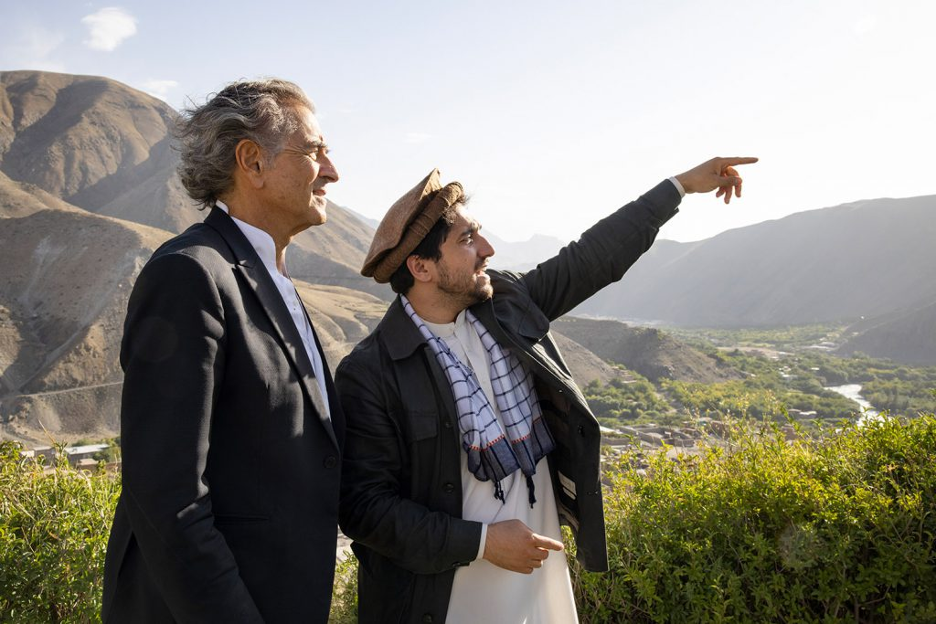
They sat and listened as my father’s friend, French philosopher Bernard-Henri Lévy, addressed them. “When you fight for your freedom,” Lévy said, “you fight also for our freedom.” Source: Bernard-Henri Lévy
Alas, Massoud was dead and thus not able to prevent the disastrous US-Afghanistan War. In the wake of the US withdrawal from Afghanistan, the name Massoud again appeared in US media. This time, it was Ahmad Massoud, the son of the assassinated Northern Alliance commander. Writing in the Washington Post, Massoud called for US assistance to fight the Taliban:
The Taliban is not a problem for the Afghan people alone. Under Taliban control, Afghanistan will without doubt become ground zero of radical Islamist terrorism; plots against democracies will be hatched here once again. […] America and its democratic allies do not just have the fight against terrorism in common with Afghans. We now have a long history made up of shared ideals and struggles. There is still much that you can do to aid the cause of freedom. You are our only remaining hope.60Ahmad Massoud, “The Mujahideen Resistance to the Taliban Begins Now. But We Need Help.,” Washington Post, August 18, 2021, https://www.washingtonpost.com/opinions/2021/08/18/mujahideen-resistance-taliban-ahmad-massoud/.
It is sadly ironic that this plea would appear in the Washington Post. The paper has long been known for its connections to the American Establishment or deep state. In recent years, the paper was bought by a monopolist oligarch whose company also has a contract worth of hundreds of millions of dollars to serve as essentially the CIA’s webmaster.61Aaron Good, American Exception: Empire and the Deep State (New York, NY: Skyhorse Publishing, 2022), 203-206, https://www.skyhorsepublishing.com/9781510769137/american-exception/. Thus, the son of a storied Afghani nationalist found himself pleading for support to the same forces that were likely involved in the assassination of his father. It is a sad footnote to the larger history whose trajectory seems to be continuing apace—the decline of US-led Western imperialism.
An earlier version of this article was published at CovertAction Magazine.
Special thanks to Seamus McGuinness for his editorial work on this article and series!

